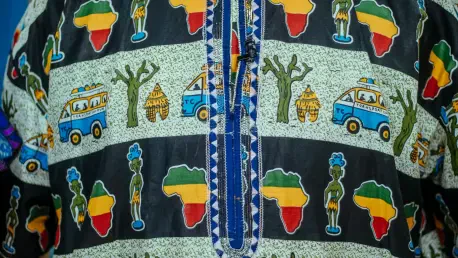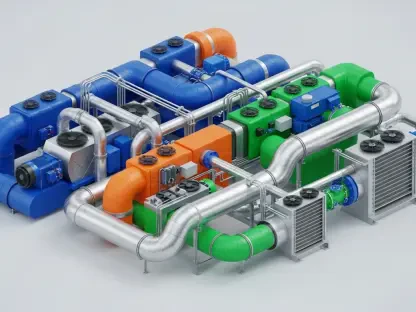South Africa’s clothing and textile sector, a cornerstone of the nation’s economy that employs between 60,000 and 80,000 individuals, finds itself at a pivotal moment, grappling with an array of formidable global and domestic hurdles. Representing approximately 14% of the country’s manufacturing jobs, this industry faces intense international competition, systemic inefficiencies, and shifting market demands that test its resilience. Despite these daunting obstacles, there are signs of potential recovery through innovative policy frameworks and collaborative efforts that aim to secure its future. Insights from industry experts, such as Courtney Grant, Principal Consultant at BMA and Chief Facilitator of the Cape and KwaZulu-Natal Clothing and Textile Clusters, shed light on the multifaceted nature of these challenges. This exploration dives deep into the barriers stifling growth, the impact of global market forces, and the strategic initiatives designed to reinvigorate a sector critical to South Africa’s economic fabric.
Unpacking Systemic Productivity Issues
The narrative surrounding South Africa’s textile industry often centers on the misconception that high labor costs are the primary barrier to competing on a global stage. However, a closer examination reveals that productivity, rather than wages, is the true stumbling block. Systemic inefficiencies, such as frequent power outages known as load shedding, bring production to a grinding halt by idling machinery for hours. Additionally, port bottlenecks cause significant delays in the importation of raw materials, further hampering output. These disruptions are not reflective of worker performance but rather of broader infrastructural shortcomings that plague the sector. Addressing these issues requires a concerted effort to modernize facilities and streamline logistics, ensuring that manufacturers can operate without constant interruptions and maintain a steady flow of goods to meet market demands.
Beyond the immediate disruptions, the ripple effects of these systemic issues are felt throughout the supply chain, eroding the industry’s ability to compete with more agile international players. The constant threat of power cuts forces companies to invest in costly backup systems, while port delays inflate operational costs and jeopardize delivery timelines. This creates a vicious cycle where reduced efficiency leads to higher prices, making South African products less attractive compared to cheaper imports. Industry leaders argue that resolving these bottlenecks is not just a matter of convenience but a critical step toward rebuilding trust with buyers and securing a foothold in global markets. Until these foundational problems are tackled, the sector will struggle to shed its reputation for unreliability, regardless of the quality or affordability of its offerings.
Navigating the Threat of Global Fast-Fashion Giants
The rise of fast-fashion behemoths like Shein and Temu has introduced a formidable challenge to South Africa’s textile manufacturers, disrupting the local market with cutthroat pricing and questionable trade practices. Until legislative updates in November 2024 tightened import duty regulations, these online platforms often sidestepped full taxation, creating an unfair advantage over domestic producers. This disparity not only undercuts local businesses but also threatens the livelihoods of thousands employed in the sector. The dominance of e-commerce giants reflects a broader global shift toward digital retail, where speed and low cost often trump considerations of origin or economic impact, leaving South African firms scrambling to adapt to a rapidly changing competitive landscape.
Compounding this issue is the lack of obligation for offshore retailers to source locally, which further diminishes the market share of domestic manufacturers. The aggressive pricing strategies employed by these international players exploit consumer preference for affordability, often at the expense of quality and ethical production standards. This trend poses a significant risk to job creation within South Africa, as every purchase from a foreign platform represents a missed opportunity for local economic growth. Industry advocates are pushing for stronger regulatory measures to ensure a level playing field, emphasizing that without such interventions, the textile sector may continue to lose ground. The urgency to address this imbalance cannot be overstated, as sustained losses could lead to irreversible damage to an already vulnerable industry.
Balancing Sustainability with Economic Realities
Sustainability has emerged as a pressing topic in the global fashion arena, yet its application within South Africa’s textile industry remains fraught with complexity due to deep economic divides. Often described as “two countries in one,” the nation features a small, affluent demographic that prioritizes eco-friendly products, while the vast majority of consumers are driven by the need for affordability. This dichotomy means that sustainable fashion struggles to gain widespread traction, as green alternatives are frequently priced out of reach for most buyers. For an industry already battling multiple challenges, aligning with global environmental trends without alienating cost-conscious customers presents a delicate balancing act that requires innovative solutions.
The challenge of integrating sustainability is further complicated by the limited resources available to many South African manufacturers, who often lack the capital to invest in greener technologies or processes. While international markets increasingly demand transparency and eco-conscious practices, local firms find themselves caught between meeting these expectations and maintaining competitive pricing. Industry observers note that for sustainability to become a viable focus, green products must achieve cost parity with conventional options, a goal that remains elusive without significant governmental or private sector support. Until such measures are in place, environmental considerations are likely to remain a secondary priority for a sector focused on survival amidst more immediate economic pressures.
Addressing Infrastructure Gaps and Regional Disparities
Infrastructure deficiencies stand as a critical impediment to the growth of South Africa’s textile industry, with port inefficiencies causing persistent delays in the movement of raw materials and finished goods. These bottlenecks disrupt the entire supply chain, inflating costs and damaging the sector’s reputation for reliability among international buyers. In contrast, regions like the Western Cape benefit from superior infrastructure, including well-maintained roads and dependable basic services, which provide a notable advantage over other areas. This uneven distribution of resources highlights a national pattern of regional disparities that must be addressed to ensure equitable industrial development across the country.
The impact of these infrastructural challenges extends beyond mere logistics, influencing the overall perception of South Africa as a viable manufacturing hub. Companies operating in less-developed regions face higher operational hurdles, often deterring potential investors who seek stability and efficiency. To counteract this, targeted investments in port upgrades and energy reliability are essential to level the competitive landscape. Enhancing infrastructure not only boosts productivity but also signals to global partners that the nation is committed to fostering a conducive business environment. Without such improvements, the industry risks being overshadowed by countries with more robust systems, further marginalizing South African textile producers in the international market.
Collaborative Strategies for a Resilient Future
In the face of mounting challenges, collaborative initiatives offer a promising path forward for South Africa’s textile sector, with frameworks like the Retail-Clothing, Textile, Footwear and Leather (R-CTFL) Master Plan leading the charge. Launched several years ago, this plan seeks to elevate local market share to 65% by 2030 through a unique partnership among retail, government, labor, and manufacturing stakeholders. By fostering a shared vision of growth and profitability, it aims to strengthen the domestic value chain while creating quality, compliant jobs. Such unified efforts underscore the importance of collective action in tackling systemic issues and positioning the industry to thrive in a competitive global economy.
Complementing this policy is the work of the Cape Clothing and Textile Cluster, which drives innovation by integrating international best practices into local operations. Through initiatives like adopting lean manufacturing techniques and organizing global learning experiences—such as factory visits and industry expos—the cluster equips South African firms with the tools to enhance efficiency and competitiveness. These endeavors reflect a broader commitment to knowledge-sharing and technological advancement as critical components of resilience. By bridging the gap between local capabilities and global standards, such collaborative strategies provide a blueprint for sustainable progress, offering hope that the sector can overcome its current struggles through unity and innovation.
Charting the Path Ahead with Policy and Innovation
Reflecting on the journey of South Africa’s textile industry, it becomes clear that past efforts to navigate global competition and domestic constraints laid a complex foundation for today’s landscape. Years of battling systemic inefficiencies, from power outages to port delays, tested the sector’s endurance, while the rise of fast-fashion giants reshaped market dynamics in ways that demanded rapid adaptation. Collaborative frameworks and regional advantages, particularly in areas like the Western Cape, offered moments of reprieve, yet the struggle to balance sustainability with affordability persisted as a defining tension. Each challenge encountered served as a lesson in resilience, shaping an industry determined to redefine its place in the global arena.
Looking forward, the focus must shift to actionable solutions that build on these hard-earned insights. Bold policy reforms, such as tax incentives for labor-intensive manufacturing, could attract investment and spur job creation, providing a sustainable alternative to short-term financial aid. Simultaneously, continued investment in infrastructure and innovation through clusters and partnerships will be vital to enhancing productivity and global competitiveness. By prioritizing systemic improvements and fair trade regulations, South Africa’s textile sector can carve out a future where it not only survives but thrives, setting an example for other industries facing similar global pressures.









